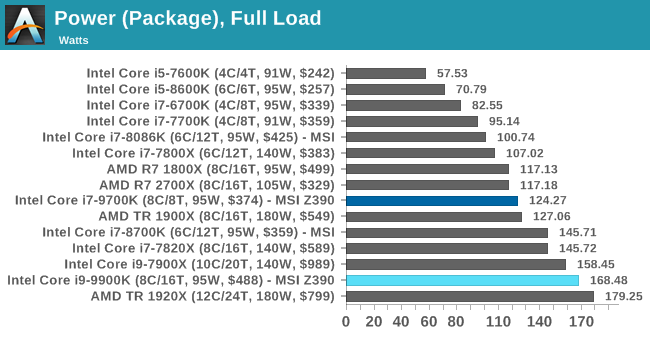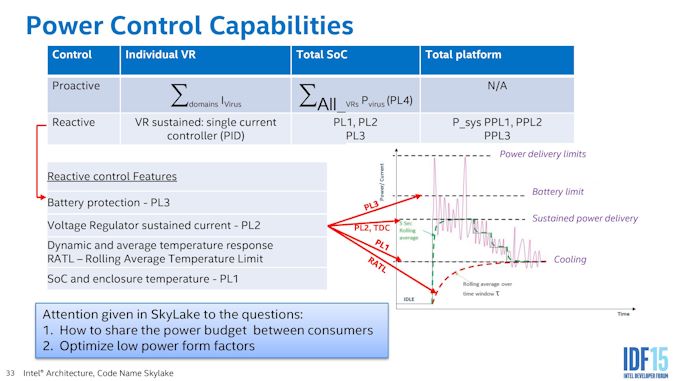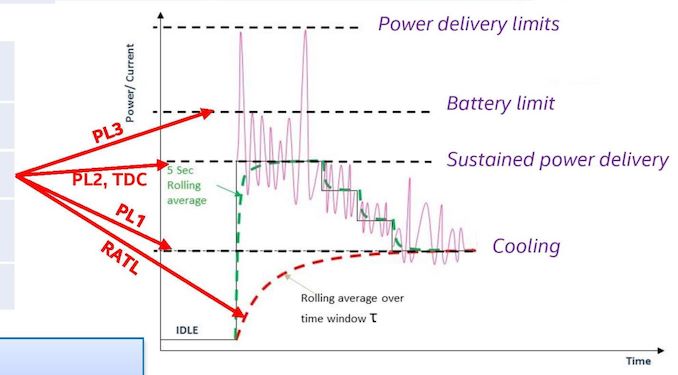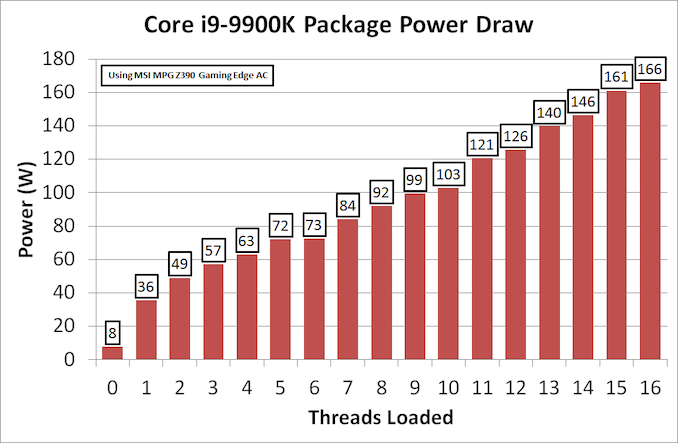The Intel 9th Gen Review: Core i9-9900K, Core i7-9700K and Core i5-9600K Tested
by Ian Cutress on October 19, 2018 9:00 AM EST- Posted in
- CPUs
- Intel
- Coffee Lake
- 14++
- Core 9th Gen
- Core-S
- i9-9900K
- i7-9700K
- i5-9600K
Power Consumption
TDP or not the TDP, That is The Question
Notice: When we initially posted this page, we ran numbers with an ASRock Z370 board. We have since discovered that the voltage applied by the board was super high, beyond normal expectations. We have since re-run the numbers using the MSI MPG Z390 Gaming Edge AC motherboard, which does not have this issue.
As shown above, Intel has given each of these processors a Thermal Design Power of 95 Watts. This magic value, as mainstream processors have grown in the last two years, has been at the center of a number of irate users.
By Intel’s own definitions, the TDP is an indicator of the cooling performance required for a processor to maintain its base frequency. In this case, if a user can only cool 95W, they can expect to realistically get only 3.6 GHz on a shiny new Core i9-9900K. That magic TDP value does not take into account any turbo values, even if the all-core turbo (such as 4.7 GHz in this case) is way above that 95W rating.
In order to make sense of this, Intel uses a series of variables called Power Levels: PL1, PL2, and PL3.
That slide is a bit dense, so we should focus on the graph on the right. This is a graph of power against time.
Here we have four horizontal lines from bottom to top: cooling limit (PL1), sustained power delivery (PL2), battery limit (PL3), and power delivery limit.
The bottom line, the cooling limit, is effectively the TDP value. Here the power (and frequency) is limited by the cooling at hand. It is the lowest sustainable frequency for the cooling, so for the most part TDP = PL1. This is our ‘95W’ value.
The PL2 value, or sustained power delivery, is what amounts to the turbo. This is the maximum sustainable power that the processor can take until we start to hit thermal issues. When a chip goes into a turbo mode, sometimes briefly, this is the part that is relied upon. The value of PL2 can be set by the system manufacturer, however Intel has its own recommended PL2 values.
In this case, for the new 9th Generation Core processors, Intel has set the PL2 value to 210W. This is essentially the power required to hit the peak turbo on all cores, such as 4.7 GHz on the eight-core Core i9-9900K. So users can completely forget the 95W TDP when it comes to cooling. If a user wants those peak frequencies, it’s time to invest in something capable and serious.
Luckily, we can confirm all this in our power testing.
For our testing, we use POV-Ray as our load generator then take the register values for CPU power. This software method, for most platforms, includes the power split between the cores, the DRAM, and the package power. Most users cite this method as not being fully accurate, however compared to system testing it provides a good number without losses, and it forms the basis of the power values used inside the processor for its various functions.
Starting with the easy one, maximum CPU power draw.

Focusing on the new Intel CPUs we have tested, both of them go beyond the TDP value, but do not hit PL2. At this level, the CPU is running all cores and threads at the all-core turbo frequency. Both 168.48W for the i9-9900K and 124.27W for the i7=9700K is far and above that ‘TDP’ rating noted above.
Should users be interested, in our testing at 4C/4T and 3.0 GHz, the Core i9-9900K only hit 23W power. Doubling the cores and adding another 50%+ to the frequency causes an almost 7x increase in power consumption. When Intel starts pushing those frequencies, it needs a lot of juice.
If we break out the 9900K into how much power is consumed as we load up the threads, the results look very linear.
This is as we load two threads onto one core at a time. The processor slowly adds power to the cores when threads are assigned.
Comparing to the other two ‘95W’ processors, we can see that the Core i9-9900K pushes more power as more cores are loaded. Despite Intel officially giving all three the same TDP at 95W, and the same PL2 at 210W, there are clear differences due to the fixed turbo tables embedded in each BIOS.
So is TDP Pointless? Yes, But There is a Solution
If you believe that TDP is the peak power draw of the processor under default scenarios, then yes, TDP is pointless, and technically it has been for generations. However under the miasma of a decade of quad core processors, most parts didn’t even reach the TDP rating even under full load – it wasn’t until we started getting higher core count parts, at the same or higher frequency, where it started becoming an issue.
But fear not, there is a solution. Or at least I want to offer one to both Intel and AMD, to see if they will take me up on the offer. The solution here is to offer two TDP ratings: a TDP and a TDP-Peak. In Intel lingo, this is PL1 and PL2, but basically the TDP-Peak takes into account the ‘all-core’ turbo. It doesn’t have to be covered under warranty (because as of right now, turbo is not), but it should be an indication for the nature of the cooling that a user needs to purchase if they want the best performance. Otherwise it’s a case of fumbling in the dark.














274 Comments
View All Comments
SanX - Thursday, October 25, 2018 - link
How come i7-7800x outperforms i9-9900 by the killing factor of 3-4 in particle movement? Is it not as "hand tunable" as older gen chips?davidk3501 - Thursday, October 25, 2018 - link
This is an overclockable processor, allowing users to push the frequency if the cooling is sufficient, and despite the memory controller still rated at DDR4-2666, higher speed memory should work in almost every chip. The Core i9-9900K also gets a fully-enabled cache, with 2 MB available per core for a chip-wide total of 16 MBashlord - Thursday, October 25, 2018 - link
My son's 4690K just blew up at such a shitty time. 8th gen 8400 is a decent replacement but 9th gen is out, so I don't really want to buy a previous gen item. I am guessing the '9400' will be out in a month or two. Going the AMD route has its issues too. It seems that AMD processors still have some issues with virtual appliances built using an older kernel. And in the past 30 years of computer ownership, I have never upgraded the processor. Components like motherboard or ram usually fail way before the CPU goes poof.In my country, R5 2600 w/Gigabyte Aorus B450M, 16GB of TridentZ RGB and a Cryorig M9+ goes for S$751. 8400 with MSI H310M Pro-M2, G.Skill Ripjaws V2400 and the same cooler goes for S$710.
ARgh!!! Don't know what to choose! Or maybe I should just give him my 6700K and get myself a new shiny toy.
nukunukoo - Friday, October 26, 2018 - link
I'm glad competition from AMD is back. Just a little over three years ago, an 8-core Intel would be a Xeon costing an arm and a leg!Dragonrider - Monday, October 29, 2018 - link
Just a note re the IGP. If you are going to try to watch 4k Blu-ray on your computer, you NEED that Intel IGP. I don't think there is any other solution to the DRM. For some, that alone would be a reason to get the Intel processor, all else being in the same ballpark.y2k1 - Wednesday, October 31, 2018 - link
What about performance pet watt? Is it basically the same as last gen?hanselltc - Thursday, November 1, 2018 - link
wat bout 9700k vs 9900k in gaming thoAlways_winter - Wednesday, November 28, 2018 - link
what cpu cooler did you usepoohbear - Monday, December 10, 2018 - link
Wow that 10nm CPU is taking forever eh? AMD is to release 7nm CPUs next month, and intel can't produce 10nm in 2019? What happened exactly?ROGnation7 - Saturday, February 23, 2019 - link
Watching all these benchmarks nowadays and taking count on how well optimised games are these days , at last the AAA titles , makes you think if it even worth it to spend more than 300-350 bucks on CPUs for gaming . Just look at i5-9600k and r5 2600x going toe to toe with high end CPUs with a decent graphics card.